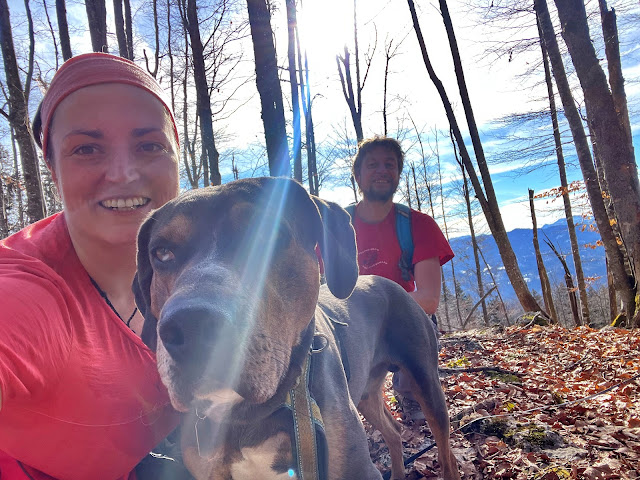Slovenia: Poljanska Baba, Planski vrh & Snowy Cave
Even though the Spring is not here yet, it was a very warm day and Nada, Bronco and me used it to explore some less known peaks of Mežakla plateau. We drove to village Kočna, where we left our car and then we started hiking. Our first stop was 8 m high solitary rock, that is called Poljanska Baba. We continued to Planski vrh and later on to natural bridge on Mežakla. Soon we returned back via cave Snežna jama and mountain pasture Planina Obranca - Garmin Connect.
 |
| I think it really is 5 minutes to the top. |
This solitary 8-meter-high rock formation has a striking shape that, with some imagination, resembles a female figure. The unique shape of the rock has inspired a local legend that adds a mystical aura to its presence.
Legend has it that the unusual and very distinctive shape of the rock was named Baba after a hard-hearted and ruthless daughter of a noble family. One day, the nobility of Mežakla had fun hunting game. The evil lord's daughter stood on the edge of a rocky overhang and watched the grove. At that moment, one of the beasts attacked the farmer, the hunter had already raised his rifle to shoot the beast, but the maiden stopped him. Everyone silently watched as the beast killed the farmer. At that moment, the sky opened and lightning turned the young lord's daughter into a rock.
 |
| One of the first selfies today. With Baba, off course. |
 |
| View from the paragliding take off site on our way. We can see Sava valley, Karawanks with its highest peak, Ljubljana basin and Kamnik-Savinja Alps. |
 |
| On April 9, 2009 at three a.m. the inhabitants of the Zgornjesavska dolina valley and Austria's Carinthia region were woken up by a loud bang and eyewitnesses saw a very bright flash in the sky. All sky meteor cameras detected a shine up to 30-times greater than that of the full moon. All of this was a consequence of a meteorite entering the atmosphere at a speed of 14 km/s. The meteorite exploded in the atmosphere and fell on the wider Mežakla area, measuring around 800 hectares. Only three pieces were found: the first largest piece named BOJO was discovered by Jožef Pretnar and Bojana Krajnc on May 17, 2009; the second piece was discovered on August 27, 2009 by Danijel Repe; and the third was found on June 21, 2009 by Germans Ralph Sporn and Martin Neuhofer. A scientific analysis found that the meteorite circulated between Mars and Jupiter for about 4.5 billion years. The Jesenice meteorite is only the eleventh meteorite in the world whose orbit has been precisely calculated by astronomers. With its astronomical data it therefore represents an outstanding object in the geological heritage of Slovenia. |
 |
| One more selfie on top of Planski vrh, 1299 m. |
The natural bridge on Mežakla, located right on the edge of the Triglav National Park, was created due to the erosive action of water and the weathering of rocks of varying resistance. This approximately 15m long, 3m wide and 8m high natural arch is especially beautiful in the springtime. Since it lies on the edge of the Plateau, we also saw Jesenice from above.
Mežakla is mainly composed of limestone and dolomite, and in some places marlstone and sandstone. Such a composition of rocks led to the creation of a typical Karst relief with numerous smaller and larger sinkholes. The cave lies at an altitude of 1109 m and is 70 m long and 20 m deep. There are two entrances, the western diagonal entrance and the eastern vertical entrance. They are separated by a natural bridge.
Over the winter, a lot of snow accumulates in the sinkhole. Due to its shaded position and cooler air, snow and ice are preserved for a long period of time. According to locals, the cave was once used to collect ice for obtaining water for shepherds and forest workers. During the second world war partisans used it for storing food.
 |
| Mountain pasture Planina Obranca lies in the south-east part of Mežakla at 1035 m above sea level. 10 to 15 heads of cattle still graze there in Summer. |
Remains of the shepherd's hut.
 |
| Monument for partisans that fought in WW2. |
Geocache found:













No comments:
Post a Comment